New (Hybrid) Kid On The Block
Can you remember back 17 years? Of note, other than that you may have had more hair or at a minimum a different style, is that this is when Toyota first sold the Prius in the United States. In 2000, the hybrid concept was foreign to most people. It earned a reputation for only being of interest to university-educated tree huggers and other assorted fringe players. Obviously, things have changed–and mightily at that! If an auto manufacturer doesn’t offer at least one hybrid in 2017, they are being left in the sales, image and technological dust. Woe be to a car company that isn’t in this space or doesn’t have strong plans to get in real, real soon.
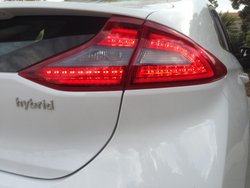
Over the past decade-and-a-half all hybrids were compared to the Prius, the gasoline+electric sales leader. As hybrid buyers have spread among all age, economic and education groups, hybrid offerings from car companies have become very competitive with some interesting and compelling vehicles to buy. There are sedans, hatchbacks, sports cars, luxury models, small SUVs and soon we will see trucks and vans. It will only be a short time before auto manufacturers offer one of each model they sell with some sort of electrified propulsion.
Hyundai’s Electric History
Hyundai dipped its toe in the electric drive business with the 2011 Sonata Hybrid. They added a plug-in model, but this is the big year with three electrified cars–the Ioniq line-up. (We don’t think the 54 Tucson fuel cell electrics sold really count, although they are real.)
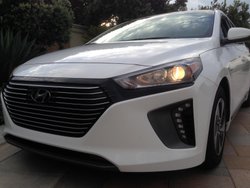
Clean Fleet Report reviewed the 2017 Ioniq Electric and compared the EV and Hybrid, now we take a look at the 2017 Ioniq Hybrid alone. Look for our review of the 2018 Ioniq Plug-in Hybrid (PHEV) soon.
With its debut, the Ioniq Hybrid became Hyundai’s non-plug-in fuel economy leader with the Blue model getting an impressive 57 city/59 highway/58 combined miles per gallon. Get on the highway with the 11.9 gallon fuel tank topped-off, and you can drive a whopping 702 miles before having to stop and refuel.
Something Borrowed, Something Cool
The 2017 Hyundai Ioniq Hybrid shares its underpinnings with the Kia Niro, which Clean Fleet Report positively reviewed, so we were expecting good things from the Ioniq Hybrid. The parallel hybrid powertrain of a 1.6L gasoline engine (104 horsepower/109 pounds-feet of torque) and an AC synchronous permanent magnet motor (43 hp/125 lb.-ft.) results in a total system horsepower of 139. Mated to a six-speed dual clutch transmission (DCT), the fuel economy is excellent. We were impressed with the powertrain’s smooth operation; it had torque for highway ramp sprints and passing 75+mph big rigs was easy and effortless. Acceleration was better-than-adequate, but not fast.
The hybrid system’s 1.56 kWh lithium-ion polymer (li-ion) battery is replenished through the regenerative charging system or charged by the engine. The regen technology converts kinetic energy
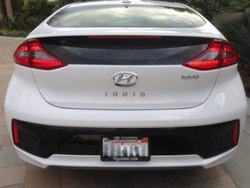
into electric energy and stores it in the battery when applying the brakes or coasting. This process can be viewed on a dash gauge where you can watch the power flow into and out of the battery, electric motor and gasoline engine. Brake pedal feel on hybrids can be grabby at times, requiring a learning period to get them right. Not so though on the Ioniq Hybrid where the regenerative braking required little pedal modulation and had a confident feel. The regenerative charging system is part of the braking system of all-wheel anti-lock brakes (ABS) with electronic brake-force distribution, brake assist, electronic stability and traction control. The Ioniq Hybrid had solid, straight and true stops.
The Ioniq Hybrid SEL model we drove had an EPA fuel economy rating of 55 city/44 highway/55 combined. Staying away from the spirited Sport mode, which can spin the tires from a stop, and keeping in the Eco mode, over 329 miles of 65-percent highway/35-percent city driving, we averaged 56.6 mpg. There is even a dash readout summarizing your driving pattern. Over our week with the car the final tally was 72-percent Economical; 26-percent Normal; 2 percent Aggressive. If you are buying a hybrid for freeway cruising where long distances with high mpg is your goal, then these numbers are just about where they should be.
Fuel economy numbers reported by Clean Fleet Report are non-scientific and represent the reviewer’s driving experience in our reviewer’s city. If you live in cold weather, high in the mountains or spend time in the city or stuck in rush hour traffic, then your numbers may differ.
Clean Slate Design
With a maturing hybrid category, manufacturers are stretching their design thinking and developing models from a blank slate. The wedge of cheese body style, made famous by Toyota with the

Prius, set the standard early on, but no more. Consumers frequently comment that the wedge shape has become passé, and to many, unappealing. Add in Toyota’s recent redesign of the Prius which, kindly, isn’t the best-looking car on the road, and those opinions are not being changed.
Hyundai’s “clean slate†challenge resulted in the Ioniq Hybrid having smooth body surfaces with few creases or sharp edges. The front LED daytime running lights are standard, positioned just below the swept-back projector headlights and above the grill with active shutters. All of these are stylish and functional, but also aid in the aerodynamic design, which has a slippery 0.24 coefficient of drag. Even the 15-inch, five spoke, Eco-spoke alloy wheels were built to cut through the wind. The hatch, with a built-in combination deck lid/spoiler that divides the glass, is bordered on each side by LED tail lamps. It took some getting used to–looking in the rearview mirror and seeing the horizontal deck lid/spoiler in the rear window–but after some mental and visualization adjustments, it became normal and natural and was not an issue.
Interior Built for Comfort
Clean Fleet Report’s Ioniq Hybrid SEL came with a nice selection of features and options. The interior was well-appointed with the dash and doors outfitted with soft and hard plastic surfaces, accented by a very tasteful use of brushed aluminum trim pieces and piano key buttons. The gauges and controls were conveniently located with a digital dash having several settings to read a wide assortment of data. The center console dividing the heated, cloth seats (power adjustable for the driver and manual for the passenger) has a leather covered shift lever, and AUX and USB charging ports along with the de rigueur cup holders.
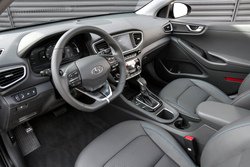
The rear cloth seats are made for grown humans: two comfortably, but three for short jaunts. Divided into two comfortable seats by the fold down armrest (with cup holders), there was ample leg, shoulder and head room. For storage, the rear seat folds 60/40 to provide excellent cargo space when two are off on a long weekend road trip.
The infotainment (information and entertainment) system was centered around the seven-inch color touchscreen. An eight-inch screen with navigation is optional. The system includes HD FM/AM, SiriusXM (90-day subscription included), Apple CarPlay and Android Auto. All of which can be managed by the controls mounted on the leather-wrapped steering wheel. Other features of the system include USB, AUX and audio input jacks and Bluetooth for voice controls and hands-free telephone calling.
Standard convenience features on the SEL trim level include dual automatic climate control, tilt and telescopic steering column, power windows with one-touch down, power door locks, power and heated foldaway exterior mirrors with turn signals. Other standard features are proximity key entry with approach lights, electronic parking brake, push button start, security alarm, a tire pressure monitoring system and a tire puncture repair kit, which replaces a spare tire.
Optional features include wireless phone charging, power tilt-and-slide sunroof, carpeted floor mats and an auto-dimming rear view mirror with Homelink and interior LED illumination.
Safety Features
Standard and optional safety features include seven airbags, blind spot detection with cross traffic alert and lane change assist, lane departure warning, rear view camera, automatic emergency braking, smart cruise control with stop/start and hill start assist.
The 2017 Hyundai Ioniq Hybrid has not been rated by the National Highway Traffic Safety Administration or the Insurance Institute for Highway Safety.
Pricing and Warranties
The base MSRP for the three 2017 Hyundai Ioniq Hybrid models.
- Ioniq Blue $22,200
- Ioniq SEL $23,950
- Ioniq Limited $27,500

Clean Fleet Report’s 2017 Hyundai Ioniq Hybrid SEL came with the optional Tech Package and carpeted floor mats that added $1,125, for a total of $25,075. All prices do not include the $835 freight and handling charge.
The Ioniq Hybrid comes with these warranties.
- Hybrid Battery Lifetime
- New Vehicle Five Years/60,000 miles
- Hybrid Systems 10 years/100,000 Miles
- Powertrain 10 Years/100,000 miles
- Anti-Perforation Seven Years/Unlimited Miles
- Roadside Assistance Five Years/Unlimited Miles
Observations: 2017 Hyundai Ioniq Hybrid
Hyundai is on to something with its Ioniq family of electrified cars. You can get one that uses no gasoline, or the option of two that use a combination of gasoline and electricity. They are affordable, with performance, handling and ride comfort above the pack. The interiors are made with eco-friendly materials and you will not be accused of buying a wedge-shaped car just to get some electric batteries.
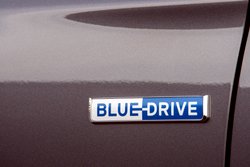
The fuel economy for the Ioniq Hybrid is excellent, rivaling the now-departed Volkswagen TDI models. And don’t forget Hyundai has the best warranty in the business. That lifetime battery warranty is crazy!
Before visiting your Hyundai dealer make sure to either make an appointment with, or speak with, a factory-trained hybrid vehicle specialist. Then treat yourself to a lengthy test drive and see for yourself how a hybrid could enhance your lifestyle.
Whatever you end up buying, enjoy your new car and as always, Happy Driving!
Second Road Test Opinion
In order to give you, the reader, the best perspective on the many vehicles available, Clean Fleet Report has a variety of contributors. When possible, we will offer you multiple perspectives on a given vehicle. This comes under SRO-Second Road Test Opinion. We hope you’ll enjoy these diverse views–some are just below—and let us know yours at publisher@cleanfleetreport.com.
Comparison Test: 2017 Hyundai Ioniq Hybrid and Electric
Road Test: 2017 Hyundai Ioniq Electric
Related Stories You Might Enjoy
Road Test: 2017 Kia Niro Hybrid (Larry’s view)
Road Test: 2017 Kia Niro Hybrid (Steve’s view)
Road Test: 2017 Kia Niro Hybrid (John’s view)
Road Test: 2016 Toyota Prius
Disclosure:
Clean Fleet Report is loaned free test vehicles from automakers to evaluate, typically for a week at a time. Our road tests are based on this one-week drive of a new vehicle. Because of this we don’t address issues such as long-term reliability or total cost of ownership. In addition we are often invited to manufacturer events highlighting new vehicles or technology. As part of these events we may be offered free transportation, lodging or meals. We do our best to present our unvarnished evaluations of vehicles and news irrespective of these inducements.
Our focus is on vehicles that offer the best fuel economy in their class, which leads us to emphasize electric cars, plug-in hybrids, hybrids and diesels. We also feature those efficient gas-powered vehicles that are among the top mpg vehicles in their class. In addition, we aim to offer reviews and news on advanced technology and the alternative fuel vehicle market. We welcome any feedback from vehicle owners and are dedicated to providing a forum for alternative viewpoints. Please let us know your views at publisher@cleanfleetreport.com.

6 thoughts on “Road Test: 2017 Hyundai Ioniq Hybrid SEL”